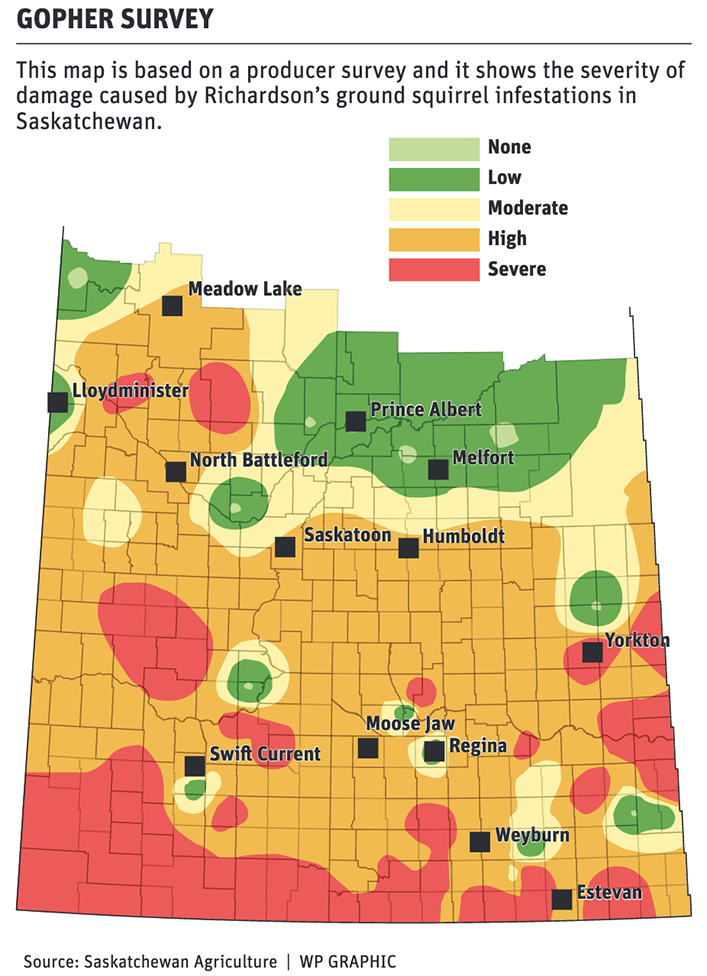SASKATOON – Richardson’s ground squirrel damage has frustrated Saskatchewan farmers for years.
Saskatchewan’s Ministry of Agriculture recently conducted a survey of farmers to better understand where Richardson’s ground squirrels are present, the methods producers use to deal with them, and which approaches are most effective.
The online survey was conducted this past December and January. A total of 174 farmers responded. They were asked questions about:
• type of acres on their farm (cropland, range, pasture, yards) affected by ground squirrels;
• number of acres affected;
• severity of damage; and
• type and effectiveness of control techniques.
James Tansey, pest management specialist with Saskatchewan Agriculture, says the province plans to conduct the survey annually to gather more accurate data.

“We’re hoping for a number of things. First and foremost is to engage with growers and gauge their satisfaction with different products, gauge that over a number of years and get some feedback from them about how we can attenuate control programs and attenuate our extension message.
“I think the ultimate goal is to get some year-to-year weather data where we can get some predictive power and can say, OK, the winter and spring have been this and in the past, this has contributed to gopher populations in these regions … and these regions should be looking at (the problem) a little bit more.”
Richardson’s ground squirrels, often referred to as gophers, can be a major problem for farmers and ranchers when present in high numbers. They can devastate crops such as cereals, hay and alfalfa and pockmark pastureland.
They are a provincially regulated agricultural pest.
“This survey seemed to be, after some discussion, the best bang for our buck. It provides the greatest engagement of growers and good information,” Tansey says.
Respondents indicated damage to cropland, pasture, range and yards. About half indicated high or medium satisfaction with the performance of poison baits. That number increased to about 78 per cent in controlled yard settings.
Shooting also ranked fairly high in terms of satisfaction as a control method.
The survey didn’t provide data on drowning, trapping or vegetation height as control methods since they aren’t practical in crop settings.
However, in smaller settings like yards, keeping vegetation height above 15 centimetres was more commonly used, though satisfaction with this method was relatively low.
The survey also showed most farmers aren’t likely to use raptor platforms as a tool to control gopher populations. Such platforms provide nesting sites for predatory birds that feed on gophers.
Tansey says that indicates the need for better communication, because raptors “can inflict some pretty significant damage on ground squirrel populations” and farmers can apply for rebates for the purchase of raptor platforms as well as bird boxes for smaller predatory birds.
Attracting raptors and other predators can also induce more stress on ground squirrels, so they move underground and have less time to damage crops.
“We would certainly like to see an uptake in that and just more of a tolerance of predators like badgers. We know they can cause a lot of damage with their burrows. But if you can tolerate that, they can be an important factor in reducing ground squirrel populations,” says Tansey.
The initial survey didn’t show the correlation between weather patterns and their impact on ground squirrel populations.
Conditions were relatively uniform in areas where ground squirrels were reported, in terms of temperature, precipitation and drought index.
“I was hoping for a little more smoking-gun evidence from a weather perspective, but this is only one year’s data. I think if we get multiple years (of) data on this, then we should get some predictive power.”
Tansey says he was pleased that responses came from throughout the province, from northern growing regions to all three borders in the south.
He was also happy with the number of responses from farmers who didn’t report a problem with ground squirrels, because that provides more objective data.
This spring will be the first time in several years that liquid strychnine will not be available for use in grain-based poisons to kill ground squirrels. Deregistration by the Pest Management Regulatory Agency went into effect March 4, 2023, after a three-year phase-out period.
Saskatchewan Agriculture, in collaboration with Alberta Agriculture, conducted a series of trials in 2022 and 2023 to assess the effectiveness and non-target safety of alternative products. Tansey says some of the most promising are zinc phosphide ready-to-use baits such as Burrow Oat Bait and ZP Rodent Oat Bait AG.
“We found that the two zinc phosphide products we tested work well and were statistically similar in their effect as strychnine and we’ve seen a real uptake of it. It’s actually a little bit less expensive than strychnine,” he says.
Zinc phosphide breaks down into phosphine gas after a gopher dies, which means there is less residue than with some other poisons.
Tansey says several anti-coagulant products also appear to be effective. He cautions that users should understand that multiple applications are required, which can boost product and labour costs.
Aluminum phosphide is another option, but it can be dangerous to handle and requires training. Tansey suggests those interested in using it should hire a professional applicator.
Persistent drought conditions in parts of the Prairies are thought to be one of the primary reasons for high ground squirrel populations in recent years.
Tansey says evidence indicates that cool, wet conditions can contribute to bacterial and fungal infections in animals. That can lead to depressed populations in some species, including ground squirrels.
Future surveys may confirm that and provide more evidence on the impact of weather on populations.




